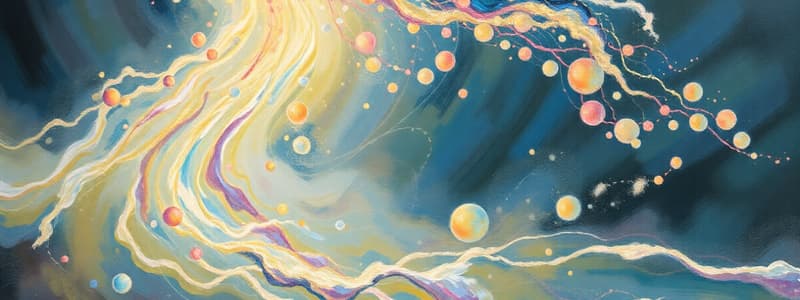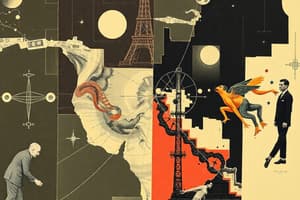Podcast
Questions and Answers
Which of the following is NOT a form of energy?
Which of the following is NOT a form of energy?
- Electrical energy
- Matter (correct)
- Chemical energy
- Magnetic energy
Energy can be created or destroyed according to the law of conservation of energy.
Energy can be created or destroyed according to the law of conservation of energy.
False (B)
What process do plants use to convert sunlight into stored energy?
What process do plants use to convert sunlight into stored energy?
Photosynthesis
When electrical energy powers a speaker, it produces ______ energy.
When electrical energy powers a speaker, it produces ______ energy.
Match the activity with its energy type:
Match the activity with its energy type:
Which activity requires energy from food for physical activities?
Which activity requires energy from food for physical activities?
Energy is only important for living things and does not affect the universe.
Energy is only important for living things and does not affect the universe.
What is the primary energy source for life on Earth?
What is the primary energy source for life on Earth?
The energy stored in food is measured in ______.
The energy stored in food is measured in ______.
What is it called when energy changes from one form to another?
What is it called when energy changes from one form to another?
Flashcards are hidden until you start studying
Study Notes
Understanding Energy
- Energy is the ability to do work, crucial for the functioning of bodies, the world, and the universe.
- Everything is either matter or energy; energy exists in various forms, such as light, heat, and electrical energy.
Forms of Energy
- Sunlight provides light and heat energy essential for life and activities.
- Electrical energy powers devices, while food contains stored energy in the form of calories.
- Energy is released through metabolic processes when consuming food, like nachos, providing the body with fuel for physical activities.
Energy and Motion
- Energy is necessary to exert force and cause motion, linking energy with forces and motion.
- Different activities at the beach exemplify energy usage: walking, dancing, and swimming all require energy.
- Sound energy arises when electrical energy powers speakers, facilitating music transmission.
Conservation of Energy
- The law of conservation of energy states that energy cannot be created or destroyed; it only changes forms.
- For example, sunlight used by plants turns into chemical energy through photosynthesis, which is stored as food.
- Electrical energy transforms into light and heat when a bulb is turned on, demonstrating energy conversion.
Everyday Energy Examples
- Physical activities like applying force to objects (e.g., a beach ball) showcase energy transforming into motion.
- Engaging in recreational activities requires energy intake, highlighting the need for energy replenishment.
Recap of Key Points
- Energy is fundamentally the ability to perform work and manifests in multiple forms (heat, electricity).
- The conservation of energy emphasizes that energy is continuously transformed, impacting daily life.
- Awareness of energy forms and their conversions enhances understanding of the natural world and energy’s role in it.
Understanding Energy
- Energy is the capacity to perform work, essential for the operation of biological systems, ecosystems, and universal phenomena.
- Everything in existence is classified as either matter or energy; energy is present in multiple forms such as light, heat, and electricity.
Forms of Energy
- Sunlight is a primary source of light and heat energy, crucial for sustaining life and enabling various activities on Earth.
- Electrical energy powers devices and technologies, while food stores energy in calorie form, critical for bodily functions.
- The body metabolizes food (e.g., nachos) to release energy, which fuels physical activities.
Energy and Motion
- Energy is essential for applying force and initiating motion, demonstrating a direct relationship between energy, forces, and movement.
- Activities such as walking, dancing, and swimming at the beach showcase practical examples of energy consumption.
- Sound energy is generated when electrical energy activates speakers, allowing for music and auditory experiences.
Conservation of Energy
- The law of conservation of energy asserts that energy cannot be created or annihilated; it only shifts between forms.
- An illustration of this is photosynthesis, where plants convert sunlight into stored chemical energy, which becomes food.
- When a light bulb is switched on, electrical energy is transformed into light and heat, exhibiting the concept of energy conversion.
Everyday Energy Examples
- Actions like throwing a beach ball demonstrate energy's transformation into kinetic energy, facilitating motion.
- Recreational activities necessitate energy intake, underscoring the importance of consuming energy to replenish what is used.
Recap of Key Points
- Energy is fundamentally a force for doing work and appears in diverse forms, including thermal and electrical energy.
- The principle of energy conservation highlights its continuous transformation, influencing daily human life and natural processes.
- Understanding the various forms and conversions of energy promotes a deeper appreciation of the natural environment and energy's vital role within it.
Studying That Suits You
Use AI to generate personalized quizzes and flashcards to suit your learning preferences.




